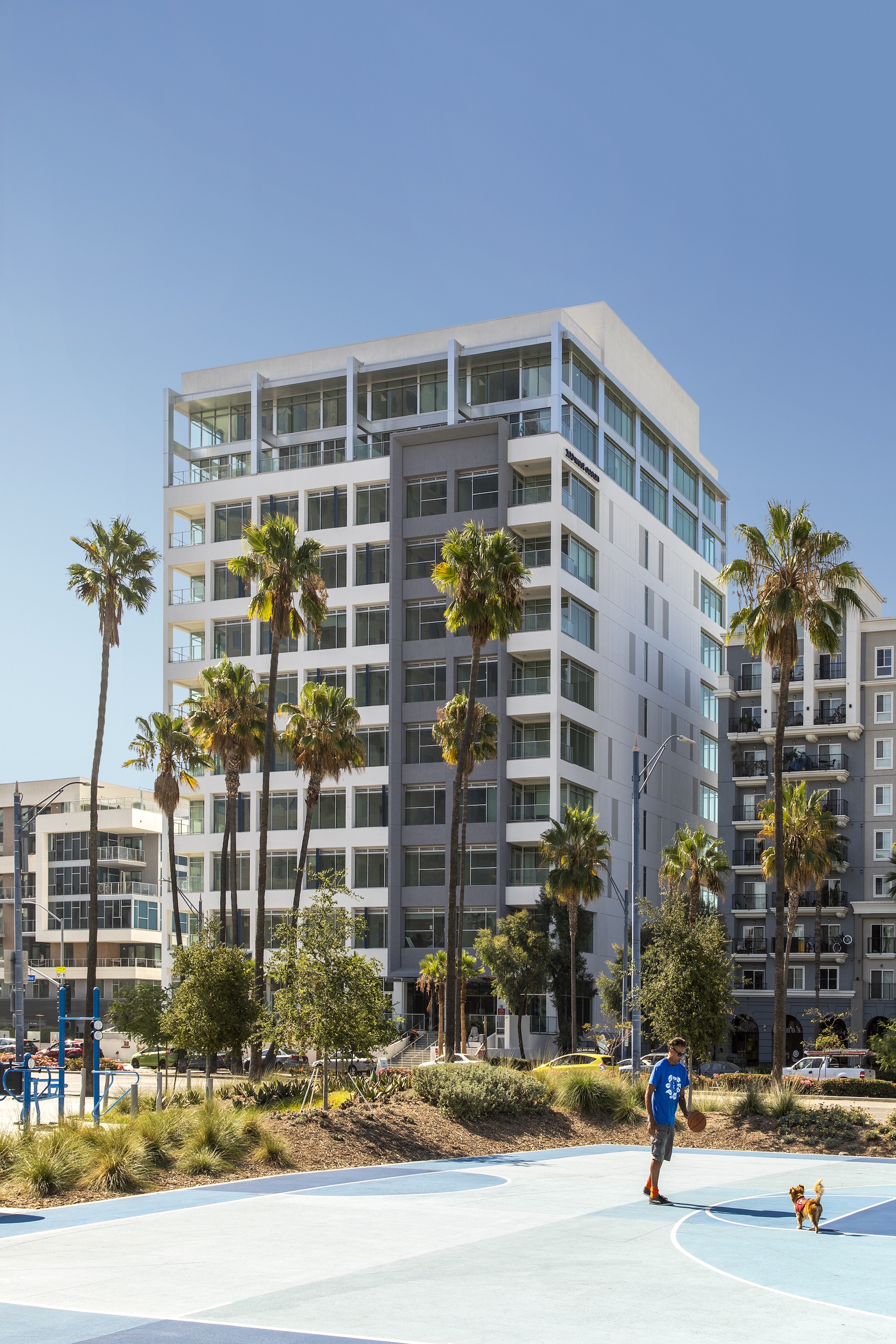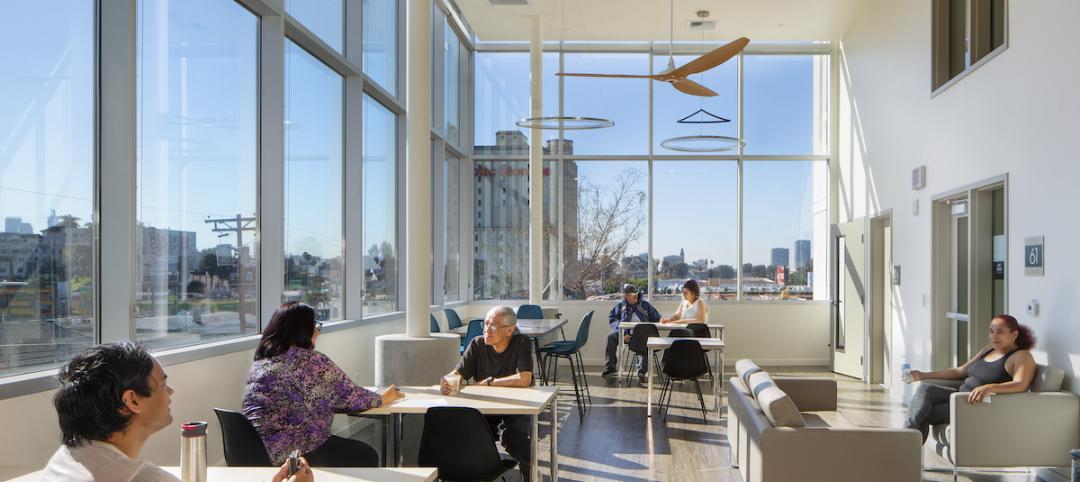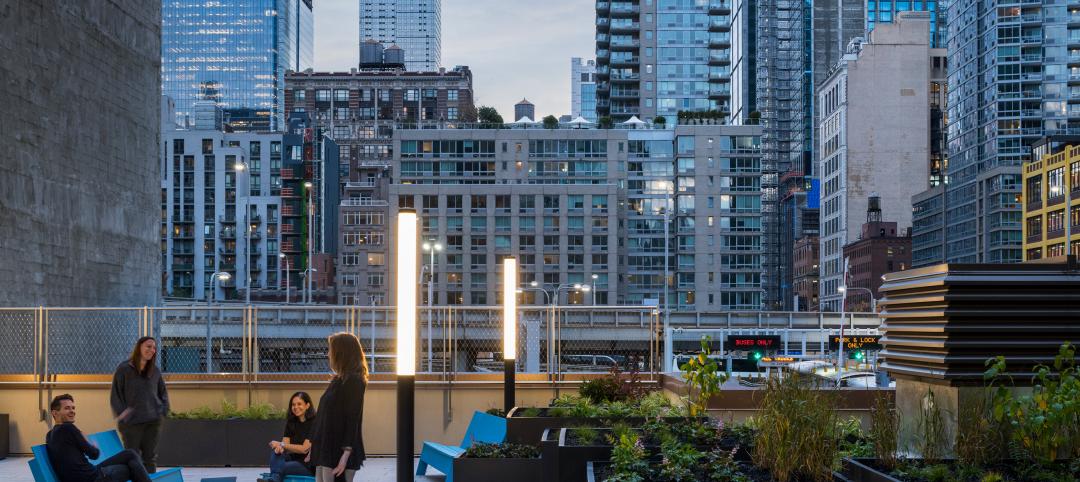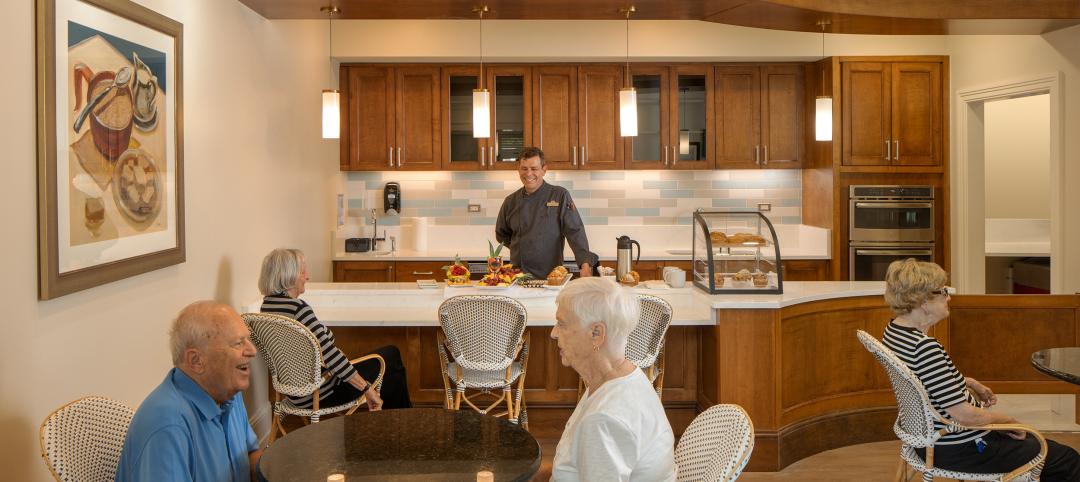A project to convert an underperforming mid-century office tower in Long Beach, Calif., created badly needed market rate housing with a significantly lowered carbon footprint. The adaptive reuse project, composed of 203,177 sf including parking, created 106 apartment units out of a Class B office building that had been vacant for about 10 years.
The $44 million 200 West Ocean project repurposed existing steel and concrete instead of trashing them, resulting in a 69% reduction in embodied carbon, an estimated 3.19 million Kg of CO2, and prevented some 26 million pounds of material from entering the waste stream.
The design included cutting slots into existing concrete to double the size of all windows, increasing natural daylight, and maximizing views for residents. This transformed an otherwise dark, insular, and flat concrete facade into an inviting, articulated building, producing a more appealing connection between the city fabric and residents.
The massing and floor plans of the building were altered to carve out balconies and outdoor terraces from the façade. More than 75% of the units have substantial natural ventilation and direct outdoor patios, allowing residents to benefit from cool ocean breezes. Recessed patios on the south side of the building reduce heat gain and maximize ocean views.

Strengthening part of the parking structure roof enabled design firm Studio One Eleven to add a community room, pool, spa, and barbecue area. Outdated mechanical equipment was removed from the roof of the main building, allowing transformation of the rooftop space into eight two-story penthouse townhomes.
The rooftop stretches beyond the glass facade of the top two stories and is lit from below at night. Interior atriums were included in the four inbound penthouse units. By creating an opening in the rooftop, bedrooms without direct windows could have natural light and ventilation as well as dramatic views through the double-height living room beyond.
Residents have just a five-minute walk to public transit that connects to downtown Los Angeles. The front sidewalk connects directly to the Pike, a promenade of dining, retail, and the Long Beach Convention Center.
On the project team:
Developer: Greystar
Design architect: Studio One Eleven
Architect of record: Studio One Eleven
MEP engineer: Donald Dickerson Assoc.
Structural engineer: Labib Funk and Assoc.
Civil engineer: KPFF
Landscape Architect: Mark Tessier Landscape
Construction Manager: JR van Dijs

Design essay from architect Studio One Eleven
Here are more details on the project from architect Studio One Eleven:
Originally designed by AC Martin and Associates in 1967, this Class B building was commissioned by the General Telephone Company of California, the largest independent telephone company in the United States during the days of the Bell System, to serve as the headquarters for the southern region. Studio One Eleven was commissioned to repurpose this oceanview building as market rate housing.
Studio One Eleven’s design pays homage to the building’s mid century architectural history and introduces renewed vibrancy with contemporary touches. The original building felt insular with an impenetrable facade and dark windows, so the renovation sought to reverse this relationship with the urban fabric and to invite views and connectivity. The addition of a gray vertical frame over the entry accentuates the building’s presence on Ocean Boulevard. To capitalize on the views and to allow more natural lighting, Studio One Eleven doubled all existing windows in size and cut slots in the concrete bulkhead to make them larger. The outdated rooftop mechanical equipment was removed and two new stories were added to give the building an iconic appearance, furthering the identity of 200 Ocean within a burgeoning downtown.
By drastically changing the floor plans and changing the massing of the building, carving outdoor balconies and terraces from the facade of the building, Studio One Eleven was able to create voluminous, varied, and light-filled units that each have access to the outdoors. The new residential units will have exposed concrete walls in the corridors, tall ceilings and many with balconies with either ocean or city views. Overall, lower units feel connected to the street while upper units are connected to views.

Utilizing the tall ground floor that was originally designed for retail, Studio One Eleven created double height lofts with mezzanines and floor to ceiling windows. On the top floors, inbound townhome units feature interior atriums, created by carving openings in the roof and allowing for interior bedrooms to have direct access to natural light and ventilation. Above the fourth floor, residents have unobstructed views southward over the waterfront, Queen Mary, and Catalina Island beyond, and northward towards downtown Los Angeles and San Gabriel Mountain range beyond. By strengthening part of the parking structure roof, Studio One Eleven was able to add an expansive ground floor amenity deck that features a pool deck and spa, community rooms, and a barbecue area for residents.
Minimizing the overall quantity of material used in a building, especially high-embodied-carbon materials such as concrete, steel, and petrochemical-based insulation products, can significantly reduce the overall embodied carbon of a project. By re-using the existing building for a new purpose, the project results in 69% lowered embodied carbon and 3.19M Kg CO2e emissions avoided, as well as over 26M lbs diverted from the waste stream.








Related Stories
Multifamily Housing | Feb 7, 2023
Multifamily housing rents flat in January, developers remain optimistic
Multifamily rents were flat in January 2023 as a strong jobs report indicated that fears of a significant economic recession may be overblown. U.S. asking rents averaged $1,701, unchanged from the prior month, according to the latest Yardi Matrix National Multifamily Report.
Giants 400 | Feb 6, 2023
2022 Reconstruction Sector Giants: Top architecture, engineering, and construction firms in the U.S. building reconstruction and renovation sector
Gensler, Stantec, IPS, Alfa Tech, STO Building Group, and Turner Construction top BD+C's rankings of the nation's largest reconstruction sector architecture, engineering, and construction firms, as reported in the 2022 Giants 400 Report.
Multifamily Housing | Feb 3, 2023
HUD unveils report to help multifamily housing developers overcome barriers to offsite construction
The U.S. Department of Housing and Urban Development, in partnership with the National Institute of Building Sciences and MOD X, has released the Offsite Construction for Housing: Research Roadmap, a strategic report that presents the key knowledge gaps and research needs to overcome the barriers and challenges to offsite construction.
Multifamily Housing | Feb 2, 2023
St. Louis’s first transit-oriented multifamily development opens in historic Skinker DeBaliviere neighborhood
St. Louis’s first major transit-oriented, multi-family development recently opened with 287 apartments available for rent. The $71 million Expo at Forest Park project includes a network of pathways to accommodate many modes of transportation including ride share, the region’s Metro Transit system, a trolley line, pedestrian traffic, automobiles, and bike traffic on the 7-mile St. Vincent Greenway Trail.
Multifamily Housing | Feb 1, 2023
Step(1) housing: A new approach to sheltering unhoused people in Redwood City, Calif.
A novel solution to homelessness will open soon in Redwood City, Calif. The compact residential campus employs modular units to create individual sleeping units, most with private bathrooms. The 240 units of housing will be accompanied by shared services and community spaces. Instead of the congregate dorm-style shelters found in many U.S. cities, this approach gives each resident a private, lockable, conditioned sleeping space.
Multifamily Housing | Jan 24, 2023
Top 10 cities for downtown living in 2023
Based on cost of living, apartment options, entertainment, safety, and other desirable urban features, StorageCafe finds the top 10 cities for downtown living in 2023.
Multifamily Housing | Jan 19, 2023
Chicago multifamily high-rise inspired by industrial infrastructure and L tracks
The recently unveiled design of The Row Fulton Market, a new Chicago high-rise residential building, draws inspiration from industrial infrastructure and L tracks in the historic Fulton Market District neighborhood. The 43-story, 300-unit rental property is in the city’s former meatpacking district, and its glass-and-steel façade reflects the arched support beams of the L tracks.
Multifamily Housing | Jan 19, 2023
Editorial call for Multifamily Affordable Housing project case studies - no cost to submit!
Building Design+Construction will feature a roundup of "Multifamily Affordable Housing" projects on BDCnetwork.com.
Multifamily Housing | Jan 12, 2023
8 noteworthy multifamily housing projects, including a refuge for unsheltered youth
Join us on a nationwide tour of notable new multifamily projects from around the country.
Senior Living Design | Jan 10, 2023
8 senior living communities that provide residents with memory care
Here are eight senior living communities that offer their residents memory care, an important service for residents who need this specialized care.

















